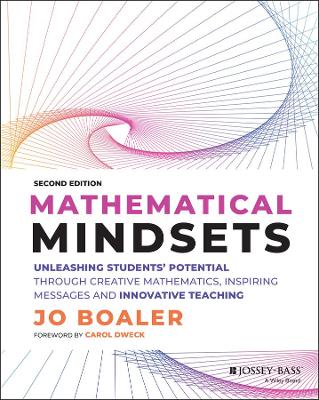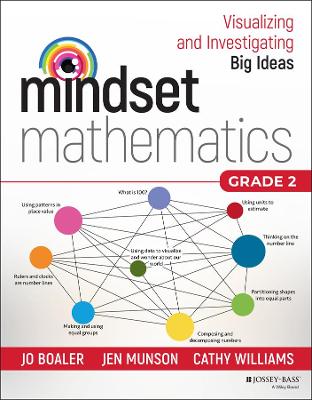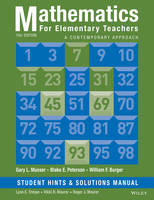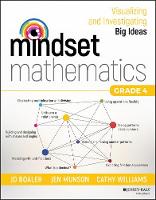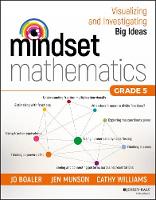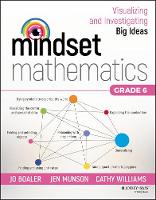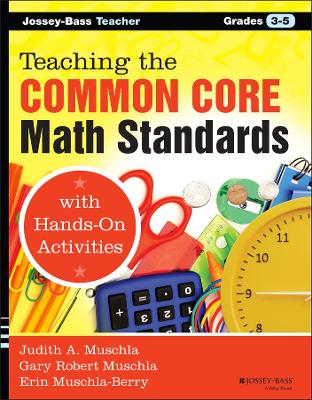Algebra Teacher's Activities Kit
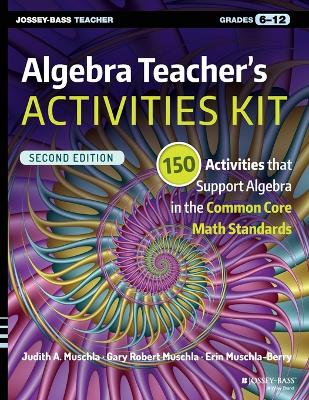 -15%
portes grátis
-15%
portes grátis
Algebra Teacher's Activities Kit
150 Activities that Support Algebra in the Common Core Math Standards, Grades 6-12
Muschla-Berry, Erin; Muschla, Gary R.; Muschla, Judith A.
John Wiley & Sons Inc
02/2016
336
Mole
Inglês
9781119045748
15 a 20 dias
780
Preface xvii
SECTION 1: RATIOS AND PROPORTIONAL RELATIONSHIPS 1
Teaching Notes for the Activities of Section 1 2
1-1: (6.RP.1) Understanding Ratios 2
1-2: (6.RP.2) Unit Rates and Ratios 2
1-3: (6.RP.3) Equivalent Ratios and the Coordinate Plane 3
1-4: (6.RP.3) Finding the Percent of a Number and Finding the Whole 3
1-5: (7.RP.1) Finding Unit Rates 4
1-6: (7.RP.2) Graphing Proportional Relationships 4
1-7: (7.RP.2) Representing Proportional Relationships 5
1-8: (7.RP.3) Solving Word Problems Involving Percents 5
Reproducibles for Section 1 6
SECTION 2: THE NUMBER SYSTEM AND NUMBER AND QUANTITY 19
Teaching Notes for the Activities of Section 2 20
2-1: (6.NS.5) Representing Positive and Negative Numbers 20
2-2: (6.NS.6) Graphing Rational Numbers on a Number Line 20
2-3: (6.NS.6) Graphing Points in the Coordinate Plane 21
2-4: (6.NS.7) The Absolute Value and Order of Rational Numbers 22
2-5: (6.NS.8) Using the Coordinate Plane to Solve Problems 22
2-6: (7.NS.1) Using the Number Line to Add and Subtract Rational Numbers23
2-7: (7.NS.1) Using Properties to Add and Subtract Rational Numbers 24
2-8: (7.NS.2) Multiplying and Dividing Rational Numbers 25
2-9: (7.NS.2) Converting Rational Numbers to Decimals26
2-10: (7.NS.3) Solving Word Problems Involving Rational Numbers 27
2-11: (8.NS.1) Expressing Fractions as Repeating Decimals and Repeating Decimals as Fractions 27
2-12: (8.NS.2) Using Rational Approximations of Irrational Numbers 28
2-13: (N-RN.1) Using the Properties of Exponents29
2-14: (N-RN.2) Rewriting Expressions Involving Radicals and Rational Exponents 29
2-15: (N-RN.3) Sums and Products of Rational and Irrational Numbers 30
2-16: (N-Q.1) Interpreting and Using Units 31
2-17: (N-Q.2) Defining Appropriate Quantities 31
2-18: (N-Q.3) Choosing Appropriate Levels of Accuracy for Measurement 32
2-19: (N-CN.1) Writing Complex Numbers 33
2-20: (N-CN.2) Adding, Subtracting, and Multiplying Complex Numbers 34
2-21: (N-CN.7) Solving Quadratic Equations That Have Complex Solutions 34
Reproducibles for Section 2 35
SECTION 3: BASIC EXPRESSIONS, EQUATIONS, AND INEQUALITIES 60
Teaching Notes for the Activities of Section 3 61
3-1: (6.EE.1) Writing and Evaluating Numerical Expressions with Whole-Number Exponents 61
3-2: (6.EE.2) Writing and Reading Algebraic Expressions 62
3-3: (6.EE.2) Evaluating Algebraic Expressions 62
3-4: (6.EE.3) Applying Properties of Operations to Generate Equivalent Expressions 63
3-5: (6.EE.4) Identifying Equivalent Expressions 63
3-6: (6.EE.5) Identifying Solutions of Equations and Inequalities 64
3-7: (6.EE.6) Writing Expressions in Which Variables Represent Numbers 64
3-8: (6.EE.7) Writing and Solving Equations 65
3-9: (6.EE.8) Using Inequalities 65
3-10: (6.EE.9) Using Variables to Represent Two Quantities 66
3-11: (7.EE.1) Adding, Subtracting, Factoring, and Expanding Linear Expressions 67
3-12: (7.EE.2) Rewriting Expressions in Different Forms 67
3-13: (7.EE.3) Solving Multi-Step Problems 68
3-14: (7.EE.4) Solving Equations and Inequalities 68
3-15: (8.EE.1) Applying Properties of Integer Exponents 69
3-16: (8.EE.2) Using Square Roots and Cube Roots 69
3-17: (8.EE.3) Using Numbers Expressed in Scientific Notation 70
3-18: (8.EE.4) Operations with Scientific Notation 71
3-19: (8.EE.5) Graphing Proportional Relationships 71
3-20: (8.EE.6) Deriving the Equation y = mx 72
3-21: (8.EE.7) Identifying Equations That Have One Solution, No Solutions, or Infinitely Many Solutions 73
3-22: (8.EE.7) Solving Equations with Variables on Both Sides 73
3-23: (8.EE.8) Solving Systems of Linear Equations Algebraically 74
3-24: (8.EE.8) Solving Systems of Equations by Graphing 75
Reproducibles for Section 3 75
SECTION 4: POLYNOMIAL, RATIONAL, EXPONENTIAL, AND RADICAL EXPRESSIONS, EQUATIONS, AND INEQUALITIES 103
Teaching Notes for the Activities of Section 4 104
4-1: (A-SSE.1) Interpreting Expressions 104
4-2: (A-SSE.2) Using the Structure of an Expression to Identify Ways to Rewrite It 104
4-3: (A-SSE.3) Factoring Quadratic Expressions to Reveal Zeroes 105
4-4: (A-SSE.3) Completing the Square to Reveal Maximum or Minimum Values 106
4-5: (A-SSE.4) Finding Sums of Finite Geometric Series 106
4-6: (A-APR.1) Adding, Subtracting, and Multiplying Polynomials 107
4-7: (A-APR.2) Applying the Remainder Theorem 107
4-8: (A-APR.3) Using Zeroes to Construct a Rough Graph of a Polynomial Function 108
4-9: (A-APR.4) Proving Polynomial Identities 109
4-10: (A-APR.6) Rewriting Rational Expressions 110
4-11: (A-CED.1) Writing and Solving Equations and Inequalities in One Variable 111
4-12: (A-CED.2) Writing and Graphing Equations in Two Variables 111
4-13: (A-CED.3) Representing Constraints and Interpreting Solutions 112
4-14: (A-CED.4) Highlighting Quantities of Interest in Formulas 113
4-15: (A-REI.1) Justifying Solutions to Equations 113
4-16: (A-REI.2) Solving Rational and Radical Equations 114
4-17: (A-REI.3) Solving Multi-Step Linear Equations in One Variable 115
4-18: (A-REI.3) Solving Multi-Step Linear Inequalities in One Variable 115
4-19: (A-REI.4) Solving a Quadratic Equation by Completing the Square 116
4-20: (A-REI.4) Solving Quadratic Equations in a Variety of Ways 116
4-21: (A-REI.5) Solving Systems of Equations 117
4-22: (A-REI.6) Solving Systems of Linear Equations 118
4-23: (A.REI.7) Solving a System of a Linear and a Quadratic Equation 118
4-24: (A-REI.10) Relating Graphs to the Solutions of Equations 119
4-25: (A-REI.11) Using Graphs and Tables to Find Solutions to Systems of Equations 120
4-26: (A-REI.12) Solving Systems of Inequalities by Graphing 120
Reproducibles for Section 4 121
SECTION 5: FUNCTIONS 155
Teaching Notes for the Activities of Section 5 156
5-1: (8.F.1) Identifying Functions 156
5-2: (8.F.2) Comparing Functions 157
5-3: (8.F.3) Determining Whether Data Lies on a Line 157
5-4: (8.F.4) Finding the Slope and Y-Intercept of a Line 157
5-5: (8.F.5) Analyzing and Graphing Functions 158
5-6: (F-IF.1) Understanding Functions 159
5-7: (F-IF.2) Finding the Values of Functions 159
5-8: (F-IF.3) Defining Sequences Recursively 160
5-9: (F-IF.4) Identifying Key Features of Graphs 160
5-10: (F-IF.5) Relating the Domain of a Function to Its Graph or Description 161
5-11: (F-IF.6) Finding the Average Rate of Change over Specified Intervals 162
5-12: (F-IF.7) Graphing Linear and Quadratic Functions 162
5-13: (F-IF.7) Graphing Polynomial Functions 163
5-14: (F-IF.8) Rewriting Quadratic Equations 164
5-15: (F-IF.9) Comparing Properties of Functions 165
5-16: (F-BF.1) Writing Functions 165
5-17: (F-BF.2) Writing Arithmetic and Geometric Sequences 166
5-18: (F-BF.3) Transforming a Function 166
5-19: (F-BF.4) Finding the Inverses of Functions 167
5-20: (F-LE.1) Proving Linear Functions Grow by Equal Differences over Equal Intervals 168
5-21: (F-LE.1) Proving Exponential Functions Grow by Equal Factors over Equal Intervals 168
5-22: (F-LE.2) Constructing Linear and Exponential Functions 169
5-23: (F-LE.3) Observing the Behavior of Quantities That Increase Exponentially 170
5-24: (F-LE.4) Writing and Solving Exponential Equations 170
5-25: (F-LE.5) Interpreting Parameters in a Linear or Exponential Function 171
5-26: (F-TF.1) Using Radian and Degree Measures 172
5-27: (F-TF.2) Using the Unit Circle 172
5-28: (F-TF.5) Modeling Periodic Phenomena 173
5-29: (F-TF.8) Finding the Values of the Sine, Cosine, and Tangent Functions 174
Reproducibles for Section 5 175
SECTION 6: STATISTICS AND PROBABILITY 221
Teaching Notes for the Activities of Section 6 222
6-1: (6.SP.1) Identifying Statistical Questions 222
6-2: (6.SP.2) Describing Data Distributions 222
6-3: (6.SP.3) Finding the Mean, Median, Mode, and Range 223
6-4: (6.SP.4) Using Dot Plots to Display Data 224
6-5: (6.SP.4) Constructing a Box Plot 224
6-6: (6.SP.5) Summarizing and Describing Data 225
6-7: (7.SP.1) Drawing Inferences from Samples 227
6-8: (7.SP.2) Drawing Inferences about a Population Using Random Samples 227
6-9: (7.SP.3) Comparing Two Data Sets 228
6-10: (7.SP.4) Drawing Inferences about Populations 229
6-11: (7.SP.5) Understanding the Probability of Events 229
6-12: (7.SP.6) Probabilities and Predictions 230
6-13: (7.SP.7) Using Probability Models to Find Probabilities of Events 230
6-14: (7.SP.8) Understanding the Probability of Compound Events 231
6-15: (7.SP.8) Finding Probabilities of Compound Events Using Tables, Lists, and Tree Diagrams 232
6-16: (8.SP.1) Constructing and Interpreting Scatter Plots 233
6-17: (8.SP.2) Fitting Lines to Data 234
6-18: (8.SP.3) Using Equations of Linear Models234
6-19: (8.SP.4) Constructing and Interpreting Two-Way Tables 235
6-20: (S-ID.1) Representing Data with Plots on the Real Number Line 236
6-21: (S-ID.2) Comparing Two Data Sets 236
6-22: (S-ID.3) Interpreting Differences in Shape, Center, and Spread of Data Distributions 237
6-23: (S-ID.4) Recognizing Characteristics of Normal Distributions 238
6-24: (S-ID.5) Summarizing Categorical Data in Two-Way Frequency Tables 238
6-25: (S-ID.6) Finding the Equation of the Line of Best Fit 239
6-26: (S-ID.6) Using Linear and Quadratic Models 240
6-27: (S-ID.7) Interpreting the Slope and Y-Intercept of a Linear Model 241
6-28: (S-ID.8) Computing and Interpreting the Correlation Coefficient 241
6-29: (S-ID.9) Distinguishing between Correlation and Causation 242
6-30: (S-IC.1) Understanding the Terminology of Statistical Experiments 242
6-31: (S-IC.2) Evaluating Probability Models through Simulations 243
6-32: (S-IC.3) Recognizing Surveys, Experiments, and Observational Studies 244
6-33: (S-IC.4) Using Simulations with Random Sampling 244
6-34: (S-IC.5) Comparing Two Treatments Using Simulations 245
6-35: (S-IC.6) Evaluating Data in Reports 246
6-36: (S-CP.1) Describing Events as Subsets of a Sample Space 246
6-37: (S-CP.2) Identifying Independent Events 247
6-38: (S-CP.3) Interpreting Conditional Probability 247
6-39: (S-CP.4) Understanding Two-Way Frequency Tables 248
6-40: (S-CP.5) Exploring Concepts of Conditional Probability 249
6-41: (S-CP.6) Finding Conditional Probabilities as a Fraction of Outcomes 249
6-42: (S-CP.7) Applying the Addition Rule 250
Reproducibles for Section 6 250
INDEX 305
Preface xvii
SECTION 1: RATIOS AND PROPORTIONAL RELATIONSHIPS 1
Teaching Notes for the Activities of Section 1 2
1-1: (6.RP.1) Understanding Ratios 2
1-2: (6.RP.2) Unit Rates and Ratios 2
1-3: (6.RP.3) Equivalent Ratios and the Coordinate Plane 3
1-4: (6.RP.3) Finding the Percent of a Number and Finding the Whole 3
1-5: (7.RP.1) Finding Unit Rates 4
1-6: (7.RP.2) Graphing Proportional Relationships 4
1-7: (7.RP.2) Representing Proportional Relationships 5
1-8: (7.RP.3) Solving Word Problems Involving Percents 5
Reproducibles for Section 1 6
SECTION 2: THE NUMBER SYSTEM AND NUMBER AND QUANTITY 19
Teaching Notes for the Activities of Section 2 20
2-1: (6.NS.5) Representing Positive and Negative Numbers 20
2-2: (6.NS.6) Graphing Rational Numbers on a Number Line 20
2-3: (6.NS.6) Graphing Points in the Coordinate Plane 21
2-4: (6.NS.7) The Absolute Value and Order of Rational Numbers 22
2-5: (6.NS.8) Using the Coordinate Plane to Solve Problems 22
2-6: (7.NS.1) Using the Number Line to Add and Subtract Rational Numbers23
2-7: (7.NS.1) Using Properties to Add and Subtract Rational Numbers 24
2-8: (7.NS.2) Multiplying and Dividing Rational Numbers 25
2-9: (7.NS.2) Converting Rational Numbers to Decimals26
2-10: (7.NS.3) Solving Word Problems Involving Rational Numbers 27
2-11: (8.NS.1) Expressing Fractions as Repeating Decimals and Repeating Decimals as Fractions 27
2-12: (8.NS.2) Using Rational Approximations of Irrational Numbers 28
2-13: (N-RN.1) Using the Properties of Exponents29
2-14: (N-RN.2) Rewriting Expressions Involving Radicals and Rational Exponents 29
2-15: (N-RN.3) Sums and Products of Rational and Irrational Numbers 30
2-16: (N-Q.1) Interpreting and Using Units 31
2-17: (N-Q.2) Defining Appropriate Quantities 31
2-18: (N-Q.3) Choosing Appropriate Levels of Accuracy for Measurement 32
2-19: (N-CN.1) Writing Complex Numbers 33
2-20: (N-CN.2) Adding, Subtracting, and Multiplying Complex Numbers 34
2-21: (N-CN.7) Solving Quadratic Equations That Have Complex Solutions 34
Reproducibles for Section 2 35
SECTION 3: BASIC EXPRESSIONS, EQUATIONS, AND INEQUALITIES 60
Teaching Notes for the Activities of Section 3 61
3-1: (6.EE.1) Writing and Evaluating Numerical Expressions with Whole-Number Exponents 61
3-2: (6.EE.2) Writing and Reading Algebraic Expressions 62
3-3: (6.EE.2) Evaluating Algebraic Expressions 62
3-4: (6.EE.3) Applying Properties of Operations to Generate Equivalent Expressions 63
3-5: (6.EE.4) Identifying Equivalent Expressions 63
3-6: (6.EE.5) Identifying Solutions of Equations and Inequalities 64
3-7: (6.EE.6) Writing Expressions in Which Variables Represent Numbers 64
3-8: (6.EE.7) Writing and Solving Equations 65
3-9: (6.EE.8) Using Inequalities 65
3-10: (6.EE.9) Using Variables to Represent Two Quantities 66
3-11: (7.EE.1) Adding, Subtracting, Factoring, and Expanding Linear Expressions 67
3-12: (7.EE.2) Rewriting Expressions in Different Forms 67
3-13: (7.EE.3) Solving Multi-Step Problems 68
3-14: (7.EE.4) Solving Equations and Inequalities 68
3-15: (8.EE.1) Applying Properties of Integer Exponents 69
3-16: (8.EE.2) Using Square Roots and Cube Roots 69
3-17: (8.EE.3) Using Numbers Expressed in Scientific Notation 70
3-18: (8.EE.4) Operations with Scientific Notation 71
3-19: (8.EE.5) Graphing Proportional Relationships 71
3-20: (8.EE.6) Deriving the Equation y = mx 72
3-21: (8.EE.7) Identifying Equations That Have One Solution, No Solutions, or Infinitely Many Solutions 73
3-22: (8.EE.7) Solving Equations with Variables on Both Sides 73
3-23: (8.EE.8) Solving Systems of Linear Equations Algebraically 74
3-24: (8.EE.8) Solving Systems of Equations by Graphing 75
Reproducibles for Section 3 75
SECTION 4: POLYNOMIAL, RATIONAL, EXPONENTIAL, AND RADICAL EXPRESSIONS, EQUATIONS, AND INEQUALITIES 103
Teaching Notes for the Activities of Section 4 104
4-1: (A-SSE.1) Interpreting Expressions 104
4-2: (A-SSE.2) Using the Structure of an Expression to Identify Ways to Rewrite It 104
4-3: (A-SSE.3) Factoring Quadratic Expressions to Reveal Zeroes 105
4-4: (A-SSE.3) Completing the Square to Reveal Maximum or Minimum Values 106
4-5: (A-SSE.4) Finding Sums of Finite Geometric Series 106
4-6: (A-APR.1) Adding, Subtracting, and Multiplying Polynomials 107
4-7: (A-APR.2) Applying the Remainder Theorem 107
4-8: (A-APR.3) Using Zeroes to Construct a Rough Graph of a Polynomial Function 108
4-9: (A-APR.4) Proving Polynomial Identities 109
4-10: (A-APR.6) Rewriting Rational Expressions 110
4-11: (A-CED.1) Writing and Solving Equations and Inequalities in One Variable 111
4-12: (A-CED.2) Writing and Graphing Equations in Two Variables 111
4-13: (A-CED.3) Representing Constraints and Interpreting Solutions 112
4-14: (A-CED.4) Highlighting Quantities of Interest in Formulas 113
4-15: (A-REI.1) Justifying Solutions to Equations 113
4-16: (A-REI.2) Solving Rational and Radical Equations 114
4-17: (A-REI.3) Solving Multi-Step Linear Equations in One Variable 115
4-18: (A-REI.3) Solving Multi-Step Linear Inequalities in One Variable 115
4-19: (A-REI.4) Solving a Quadratic Equation by Completing the Square 116
4-20: (A-REI.4) Solving Quadratic Equations in a Variety of Ways 116
4-21: (A-REI.5) Solving Systems of Equations 117
4-22: (A-REI.6) Solving Systems of Linear Equations 118
4-23: (A.REI.7) Solving a System of a Linear and a Quadratic Equation 118
4-24: (A-REI.10) Relating Graphs to the Solutions of Equations 119
4-25: (A-REI.11) Using Graphs and Tables to Find Solutions to Systems of Equations 120
4-26: (A-REI.12) Solving Systems of Inequalities by Graphing 120
Reproducibles for Section 4 121
SECTION 5: FUNCTIONS 155
Teaching Notes for the Activities of Section 5 156
5-1: (8.F.1) Identifying Functions 156
5-2: (8.F.2) Comparing Functions 157
5-3: (8.F.3) Determining Whether Data Lies on a Line 157
5-4: (8.F.4) Finding the Slope and Y-Intercept of a Line 157
5-5: (8.F.5) Analyzing and Graphing Functions 158
5-6: (F-IF.1) Understanding Functions 159
5-7: (F-IF.2) Finding the Values of Functions 159
5-8: (F-IF.3) Defining Sequences Recursively 160
5-9: (F-IF.4) Identifying Key Features of Graphs 160
5-10: (F-IF.5) Relating the Domain of a Function to Its Graph or Description 161
5-11: (F-IF.6) Finding the Average Rate of Change over Specified Intervals 162
5-12: (F-IF.7) Graphing Linear and Quadratic Functions 162
5-13: (F-IF.7) Graphing Polynomial Functions 163
5-14: (F-IF.8) Rewriting Quadratic Equations 164
5-15: (F-IF.9) Comparing Properties of Functions 165
5-16: (F-BF.1) Writing Functions 165
5-17: (F-BF.2) Writing Arithmetic and Geometric Sequences 166
5-18: (F-BF.3) Transforming a Function 166
5-19: (F-BF.4) Finding the Inverses of Functions 167
5-20: (F-LE.1) Proving Linear Functions Grow by Equal Differences over Equal Intervals 168
5-21: (F-LE.1) Proving Exponential Functions Grow by Equal Factors over Equal Intervals 168
5-22: (F-LE.2) Constructing Linear and Exponential Functions 169
5-23: (F-LE.3) Observing the Behavior of Quantities That Increase Exponentially 170
5-24: (F-LE.4) Writing and Solving Exponential Equations 170
5-25: (F-LE.5) Interpreting Parameters in a Linear or Exponential Function 171
5-26: (F-TF.1) Using Radian and Degree Measures 172
5-27: (F-TF.2) Using the Unit Circle 172
5-28: (F-TF.5) Modeling Periodic Phenomena 173
5-29: (F-TF.8) Finding the Values of the Sine, Cosine, and Tangent Functions 174
Reproducibles for Section 5 175
SECTION 6: STATISTICS AND PROBABILITY 221
Teaching Notes for the Activities of Section 6 222
6-1: (6.SP.1) Identifying Statistical Questions 222
6-2: (6.SP.2) Describing Data Distributions 222
6-3: (6.SP.3) Finding the Mean, Median, Mode, and Range 223
6-4: (6.SP.4) Using Dot Plots to Display Data 224
6-5: (6.SP.4) Constructing a Box Plot 224
6-6: (6.SP.5) Summarizing and Describing Data 225
6-7: (7.SP.1) Drawing Inferences from Samples 227
6-8: (7.SP.2) Drawing Inferences about a Population Using Random Samples 227
6-9: (7.SP.3) Comparing Two Data Sets 228
6-10: (7.SP.4) Drawing Inferences about Populations 229
6-11: (7.SP.5) Understanding the Probability of Events 229
6-12: (7.SP.6) Probabilities and Predictions 230
6-13: (7.SP.7) Using Probability Models to Find Probabilities of Events 230
6-14: (7.SP.8) Understanding the Probability of Compound Events 231
6-15: (7.SP.8) Finding Probabilities of Compound Events Using Tables, Lists, and Tree Diagrams 232
6-16: (8.SP.1) Constructing and Interpreting Scatter Plots 233
6-17: (8.SP.2) Fitting Lines to Data 234
6-18: (8.SP.3) Using Equations of Linear Models234
6-19: (8.SP.4) Constructing and Interpreting Two-Way Tables 235
6-20: (S-ID.1) Representing Data with Plots on the Real Number Line 236
6-21: (S-ID.2) Comparing Two Data Sets 236
6-22: (S-ID.3) Interpreting Differences in Shape, Center, and Spread of Data Distributions 237
6-23: (S-ID.4) Recognizing Characteristics of Normal Distributions 238
6-24: (S-ID.5) Summarizing Categorical Data in Two-Way Frequency Tables 238
6-25: (S-ID.6) Finding the Equation of the Line of Best Fit 239
6-26: (S-ID.6) Using Linear and Quadratic Models 240
6-27: (S-ID.7) Interpreting the Slope and Y-Intercept of a Linear Model 241
6-28: (S-ID.8) Computing and Interpreting the Correlation Coefficient 241
6-29: (S-ID.9) Distinguishing between Correlation and Causation 242
6-30: (S-IC.1) Understanding the Terminology of Statistical Experiments 242
6-31: (S-IC.2) Evaluating Probability Models through Simulations 243
6-32: (S-IC.3) Recognizing Surveys, Experiments, and Observational Studies 244
6-33: (S-IC.4) Using Simulations with Random Sampling 244
6-34: (S-IC.5) Comparing Two Treatments Using Simulations 245
6-35: (S-IC.6) Evaluating Data in Reports 246
6-36: (S-CP.1) Describing Events as Subsets of a Sample Space 246
6-37: (S-CP.2) Identifying Independent Events 247
6-38: (S-CP.3) Interpreting Conditional Probability 247
6-39: (S-CP.4) Understanding Two-Way Frequency Tables 248
6-40: (S-CP.5) Exploring Concepts of Conditional Probability 249
6-41: (S-CP.6) Finding Conditional Probabilities as a Fraction of Outcomes 249
6-42: (S-CP.7) Applying the Addition Rule 250
Reproducibles for Section 6 250
INDEX 305


